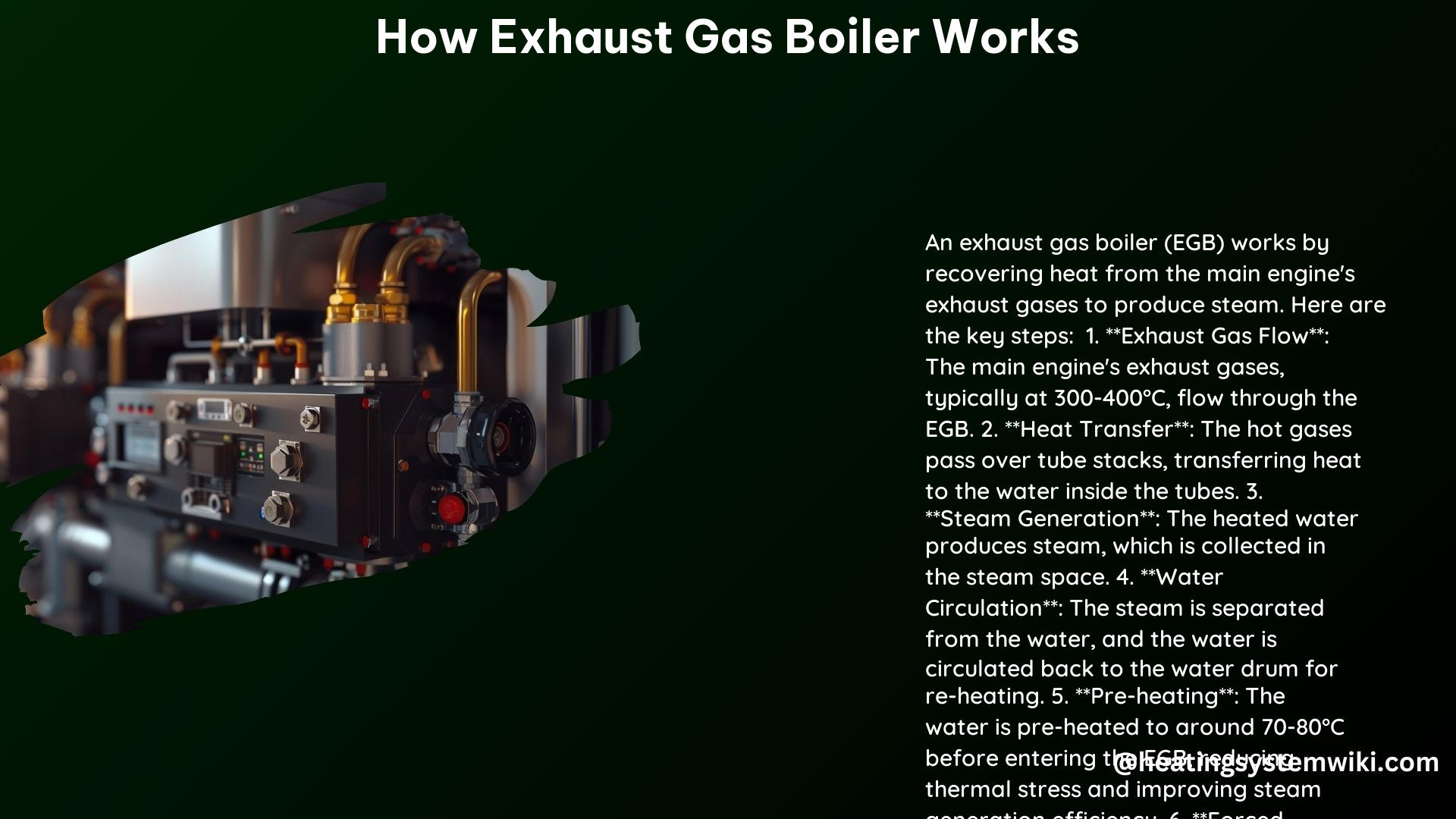An exhaust gas boiler (EGB) is a type of heat recovery system used on ships to generate steam from the exhaust heat of the main engine. This comprehensive guide will delve into the intricate workings of an EGB, providing a detailed understanding of its components, design, heat transfer process, safety features, maintenance, and technical specifications.
Components and Design
Vertical Boiler Structure
The EGB is designed as a vertical boiler with a cylindrical shell surrounding the boiler tubes and water drum, as well as the steam space. The vertical orientation allows for efficient heat transfer and compact design, making it well-suited for marine applications where space is limited.
Boiler Tubes
The boiler consists of a large number of smoke tubes, typically ranging from 50 to 150 tubes, and a smaller number of stay tubes. The stay tubes, with an increased diameter of around 50-60 mm, act as structural supports for the boiler, ensuring its integrity under high temperatures and pressures.
Water Drum and Steam Space
The water drum and steam space are formed by the shell plate and internal cone. The water drum serves as the reservoir for the boiler’s water supply, while the steam space is designed to accommodate the shrink and swell volumes of the generated steam, ensuring stable and efficient steam production.
Foundation
The boiler foundation consists of four foundation consoles, providing the necessary support and absorption of thermal expansion. This design feature is crucial in marine environments, where the boiler is subjected to constant motion and vibration, ensuring its long-term reliability and performance.
Heat Transfer Process

Exhaust Gas Flow
The exhaust gas from the main engine flows through the boiler tubes, transferring heat to the water side by convection. The high temperature of the exhaust gas, typically ranging from 300°C to 400°C, is the driving force behind the heat transfer process.
Water Side Heat Transfer
On the water side, heat is transferred by the evaporation of saturated water adjacent to the boiler tubes. As the water is heated, steam bubbles form and rise rapidly to the steam space, where water and steam are separated. This efficient heat transfer process ensures the generation of high-quality steam for various applications.
Steam Generation
The steam generated in the boiler is collected in the steam drum, where it can be used for power generation, heating, or other purposes. The design of the steam space and the separation of water and steam ensure the delivery of dry, high-pressure steam to the end-users.
Safety Features and Maintenance
Emergency Operation
The EGB is designed to withstand low water levels and even operate without water in emergency situations, provided the boiler is depressurized and the internal temperature does not exceed 400°C. This safety feature allows the boiler to continue functioning in the event of a water supply disruption or other unexpected scenarios.
Inspection and Cleaning
The boiler is equipped with hand holes and manholes for easy inspection and cleaning. Regular maintenance, including water washing or the use of soot removers, is crucial to keep the heating surfaces clean and maintain efficient heat transfer.
Fire Prevention
Soot deposits can accumulate inside the boiler tubes, leading to the risk of fires. To mitigate this hazard, regular cleaning and monitoring of differential pressure and temperature curves are essential. By maintaining the boiler’s cleanliness, the risk of soot-related fires can be significantly reduced.
Technical Specifications
Exhaust Gas Temperature
The inlet temperature of the exhaust gases entering the EGB typically ranges from 300°C to 400°C, providing a substantial amount of thermal energy to be recovered and converted into steam.
Water Inlet Temperature
The water inlet temperature is usually around 70°C to 80°C, which is preheated to avoid thermal stressing and ensure efficient steam generation. This preheating process helps to maximize the heat recovery and overall system efficiency.
Heat Transfer Surface
The dimensions of the heating surface are carefully designed to maintain a sufficient exhaust gas velocity for self-cleaning and efficient heat transfer. The specific surface area and tube arrangement are optimized to achieve the desired steam output and thermal performance.
References
- Waste Heat Boiler – an overview | ScienceDirect Topics – https://www.sciencedirect.com/topics/engineering/waste-heat-boiler
- Exhaust Gas Boiler on Ships – Marine Engineering Study Materials – https://marineengineeringonline.com/exhaust-gas-boiler/
- Types of Exhaust Gas Boiler (EGB) Fires and Ways to Prevent Them – https://www.marineinsight.com/tech/boiler/types-of-exhaust-gas-boiler-egb-fires-and-ways-to-prevent-them/
- EXHAUST GAS BOILER – WASTE HEAT RECOVERY – YouTube – https://www.youtube.com/watch?v=lSXA3EygZZs
- Considerations for exhaust gas boiler operation and thermal … – https://www.alfalaval.com/globalassets/documents/products/heat-transfer/boilers/slow-steaming-technical-bulletin-for-exhaust-gas-boilers_technical-data-sheet_en.pdf
